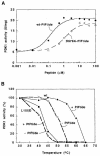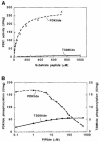Identification of a pocket in the PDK1 kinase domain that interacts with PIF and the C-terminal residues of PKA
- PMID: 10698939
- PMCID: PMC305637
- DOI: 10.1093/emboj/19.5.979
Identification of a pocket in the PDK1 kinase domain that interacts with PIF and the C-terminal residues of PKA
Abstract
The 3-phosphoinositide-dependent protein kinase-1 (PDK1) phosphorylates and activates a number of protein kinases of the AGC subfamily. The kinase domain of PDK1 interacts with a region of protein kinase C-related kinase-2 (PRK2), termed the PDK1-interacting fragment (PIF), through a hydrophobic motif. Here we identify a hydrophobic pocket in the small lobe of the PDK1 kinase domain, separate from the ATP- and substrate-binding sites, that interacts with PIF. Mutation of residues predicted to form part of this hydrophobic pocket either abolished or significantly diminished the affinity of PDK1 for PIF. PIF increased the rate at which PDK1 phosphorylated a synthetic dodecapeptide (T308tide), corresponding to the sequences surrounding the PDK1 phosphorylation site of PKB. This peptide is a poor substrate for PDK1, but a peptide comprising T308tide fused to the PDK1-binding motif of PIF was a vastly superior substrate for PDK1. Our results suggest that the PIF-binding pocket on the kinase domain of PDK1 acts as a 'docking site', enabling it to interact with and enhance the phosphorylation of its substrates.
Figures








Similar articles
-
PDK1 acquires PDK2 activity in the presence of a synthetic peptide derived from the carboxyl terminus of PRK2.Curr Biol. 1999 Apr 22;9(8):393-404. doi: 10.1016/s0960-9822(99)80186-9. Curr Biol. 1999. PMID: 10226025
-
A 3-phosphoinositide-dependent protein kinase-1 (PDK1) docking site is required for the phosphorylation of protein kinase Czeta (PKCzeta ) and PKC-related kinase 2 by PDK1.J Biol Chem. 2000 Jul 7;275(27):20806-13. doi: 10.1074/jbc.M000421200. J Biol Chem. 2000. PMID: 10764742
-
A chimeric mechanism for polyvalent trans-phosphorylation of PKA by PDK1.Protein Sci. 2009 Jul;18(7):1486-97. doi: 10.1002/pro.146. Protein Sci. 2009. PMID: 19530248 Free PMC article.
-
Intracellular signalling: PDK1--a kinase at the hub of things.Curr Biol. 1999 Feb 11;9(3):R93-6. doi: 10.1016/s0960-9822(99)80058-x. Curr Biol. 1999. PMID: 10021376 Review.
-
Phosphoinositide-dependent protein kinase 1, a sensor of protein conformation.Trends Biochem Sci. 2004 Mar;29(3):136-42. doi: 10.1016/j.tibs.2004.01.005. Trends Biochem Sci. 2004. PMID: 15003271 Review.
Cited by
-
An Update on Protein Kinases as Therapeutic Targets-Part II: Peptides as Allosteric Protein Kinase C Modulators Targeting Protein-Protein Interactions.Int J Mol Sci. 2023 Dec 15;24(24):17504. doi: 10.3390/ijms242417504. Int J Mol Sci. 2023. PMID: 38139336 Free PMC article. Review.
-
Characterization of a PDK1 homologue from the moss Physcomitrella patens.Plant Physiol. 2012 Feb;158(2):1018-33. doi: 10.1104/pp.111.184572. Epub 2011 Dec 7. Plant Physiol. 2012. PMID: 22158524 Free PMC article.
-
Phosphoinositide-dependent kinase 1 targets protein kinase A in a pathway that regulates interleukin 4.J Exp Med. 2006 Jul 10;203(7):1733-44. doi: 10.1084/jem.20051715. Epub 2006 Jun 19. J Exp Med. 2006. PMID: 16785309 Free PMC article.
-
High resolution crystal structure of the human PDK1 catalytic domain defines the regulatory phosphopeptide docking site.EMBO J. 2002 Aug 15;21(16):4219-28. doi: 10.1093/emboj/cdf437. EMBO J. 2002. PMID: 12169624 Free PMC article.
-
Orchestrating serine/threonine phosphorylation and elucidating downstream effects by short linear motifs.Biochem J. 2022 Jan 14;479(1):1-22. doi: 10.1042/BCJ20200714. Biochem J. 2022. PMID: 34989786 Free PMC article. Review.
References
-
- Alessi D.R. and Downes, C.P. (1998) The role of PI 3-kinase in insulin action. Biochim. Biophys. Acta, 1436, 151–164. - PubMed
-
- Alessi D.R., Cohen, P., Ashworth, A., Cowley, S., Leevers, S.L. and Marshall, C.J. (1994) Assay and expression of mitogen activated protein kinase, MAP kinase and Raf. Methods Enzymol., 255, 279–290. - PubMed
-
- Alessi D.R., et al. (1997a) 3-Phosphoinositide-dependent protein kinase-1 (PDK1): structural and functional homology with the Drosophila DSTPK61 kinase. Curr. Biol., 7, 776–789. - PubMed
-
- Alessi D.R., James, S.R., Downes, C.P., Holmes, A.B., Gaffney, P.R., Reese, C.B. and Cohen, P. (1997b) Characterization of a 3-phospho– inositide-dependent protein kinase which phosphorylates and activates protein kinase Bα. Curr. Biol., 7, 261–269. - PubMed
Publication types
MeSH terms
Substances
LinkOut - more resources
Full Text Sources
Other Literature Sources
Molecular Biology Databases
Miscellaneous

